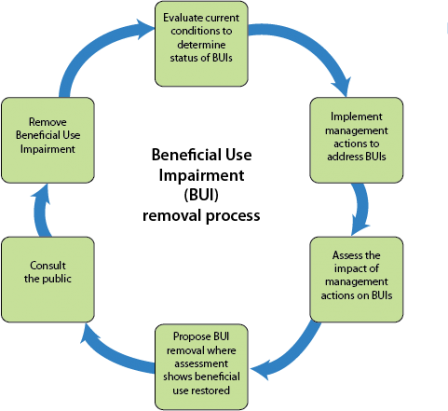Beneficial Use Impairments
What are Beneficial Use Impairments (BUIs)?
An impairment of beneficial uses means a change in the chemical, physical or biological integrity of the Great Lakes system sufficient to cause any of the following:
- Restrictions on Fish and Wildlife Consumption
- Tainting of Fish and Wildlife Flavor
- Degraded Fish and Wildlife Populations
- Fish Tumors or Other Deformities
- Bird or Animal Deformities or Reproductive Problems
- Degradation of Benthos
- Restrictions on Dredging Activities
- Eutrophication or Undesirable Algae
- Restrictions on Drinking Water Consumption or Taste and Odor Problems
- Beach Closings
- Degradation of Aesthetics
- Added Costs to Agriculture or Industry
- Degradation of Phytoplankton and Zooplankton Populations
- Loss of Fish and Wildlife Habitat
Removing BUIs is based on local restoration targets
 Cycle for removing beneficial use impairments (BUIs): determine status, take management actions, assess their impact, propose removal, consult public, remove BUI.
Cycle for removing beneficial use impairments (BUIs): determine status, take management actions, assess their impact, propose removal, consult public, remove BUI.
In order to address BUIs, each state and local advisory group created restoration targets that define success for each BUI. EPA and other federal agencies did not define explicit targets for each BUI. The International Joint Commission provided some very broad guidance on targets for each BUI in the early 1990s. However, an EPA guidance document offered these criteria for restoration targets:
- Targets should be premised on local goals and related objectives for the watershed; they should be consistent with applicable federal and state regulations, objectives, guidelines, standards and policies, when available, and the principles and objectives embodied in the AOC Annex 1 in the 2012 Great Lakes Water Quality Agreement.
- Targets should have measurable indicators and also be realistic and achievable.
- Targets should be developed and periodically reviewed on a site-specific basis (allowing for flexibility in addressing local conditions) by the respective state agencies in consultation with local stakeholders and other interested parties. This is important because as new information is developed, the states and local communities are encouraged to modify targets to effectively remove the BUIs.
